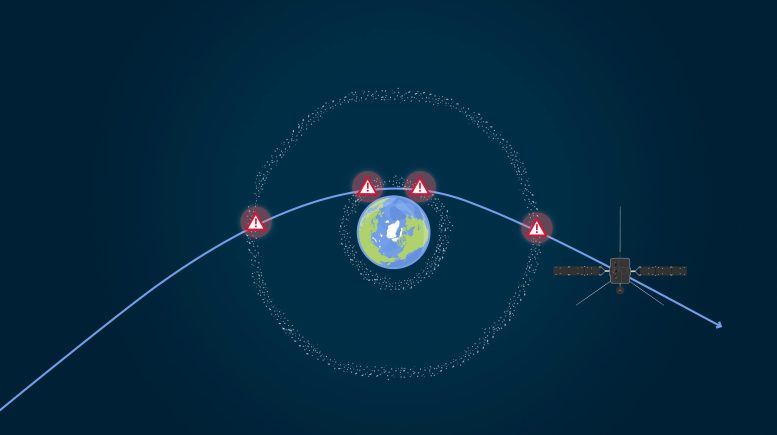
Artist impression of Solar Orbiter’s Earth flyby through the two clouds of space debris in Low Earth Orbit and Geostationary orbit. Credit: ESA
Solar Orbiter is returning to Earth for a flyby before starting its main science mission to explore the Sun and its connection to ‘space weather’. During the flyby Solar Orbiter must pass through the clouds of space debris that surround our planet, making this maneuver the riskiest flyby yet for a science mission.
Navigating risk
Solar Orbiter’s Earth flyby takes place on November 27. At 04:30 GMT (05:30 CET) on that day, the spacecraft will be at its closest approach, just 460 km above North Africa and the Canary Islands. This is almost as close as the orbit of the International Space Station.
The maneuver is essential to decrease the energy of the spacecraft and line it up for its next close pass of the Sun but it comes with a risk. The spacecraft must pass through two orbital regions, each of which is populated with space debris.
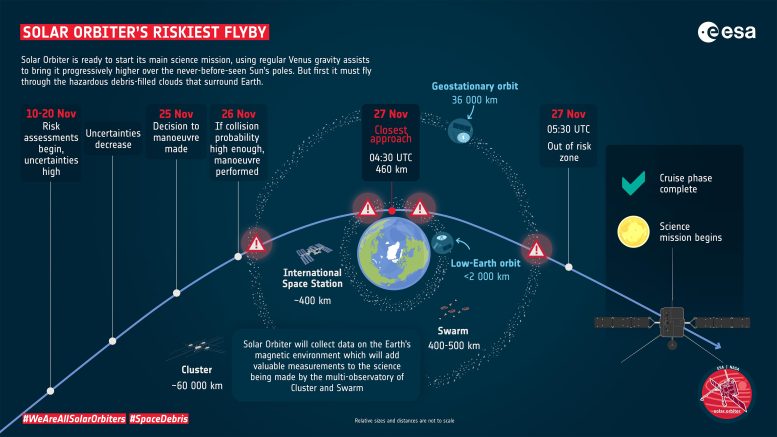
Solar Orbiter’s crucial flyby of Earth on November 27 will place the spacecraft onto the correct orbit for its science phase to begin. But the maneuver is not without risk. At closest approach, the spacecraft will be around 460 km above our planet. This is in the Low Earth Orbit zone, where the International Space Station and many other spacecraft can be found. It is also home to a lot of space debris, meaning that there is a small risk of a collision between Solar Orbiter and some space junk. To reach this region, Solar Orbiter will also have to fly through another well-used orbital region, called Geostationary orbit, which again is congested with space debris and other satellites. ESA will monitor the situation carefully and change the trajectory of the spacecraft if it needs to. However, the flyby does present a unique opportunity for science. Solar Orbiter can collect data on the Earth’s magnetic field, which can be compared to that from ESA’s Cluster and Swarm missions to give a more detailed, three dimensional description of this highly changeable region around our planet. After the flyby, regular Venus gravity assists will bring the spacecraft higher over the Sun’s never-before-seen poles, providing new details about how activity on the Sun generates space weather. Credit: ESA
The first is the geostationary ring of satellites at 36,000 km, and the second is the collection of low Earth orbits at around 400 km. As a result, there is a small risk of a collision. Solar Orbiter’s operations team are monitoring the situation very closely and will alter the spacecraft’s trajectory if it appears to be in any danger.
Earth science opportunity
On the plus side, the flyby offers a unique opportunity to study the Earth’s magnetic field. This is a subject of intense interest because the magnetic field is our atmosphere’s interface with the solar wind, the constant ‘wind’ of particles given off by the Sun. Not only can particles from the solar wind penetrate the magnetic field and spark the aurora in our skies, but atoms from our atmosphere can also be lost into space.
The details of these interactions are being studied by two ESA missions: Cluster’s four satellites at 60,000 km in altitude and Swarm’s three spacecraft at 400 km. Multiple spacecraft are needed to break the so-called space-time ambiguity. This is the name given to the uncertainty over whether a change has taken place because a spacecraft has flown into a different region with different conditions (a change in space) or is flying through a region that changes its conditions (a change in time).
Solar Orbiter’s flyby offers a unique opportunity to take even more data. It will sweep into the Earth’s magnetic field from out beyond Clusters orbit, approach Swarm’s orbit at closest approach, and then fly back out again. This will provide even more data points from which to reconstruct the condition and behavior of Earth’s magnetic field during the flyby.
“This flyby is exciting: seeing what Solar Orbiter sees in our part of space, and how that compares to what we are seeing, and if there are surprises, what are they?” says Anja Strømme, Swarm Mission Manager.
Cruise phase complete
The flyby marks a major milestone for Solar Orbiter. From its launch in February 2020 to July of that year, the spacecraft was in its commissioning phase, during which the scientists and engineers tested out the spacecraft and its instruments. From July 2020 to now, Solar Orbiter has been in the cruise phase. During this time, the in-situ instruments have been taking measurements of the solar wind and other conditions around the spacecraft, while the remote sensing instruments designed to look at the Sun have been in their extended calibration and characterization mode.
Despite Solar Orbiter not yet being in full science mode, a lot of science has been produced.
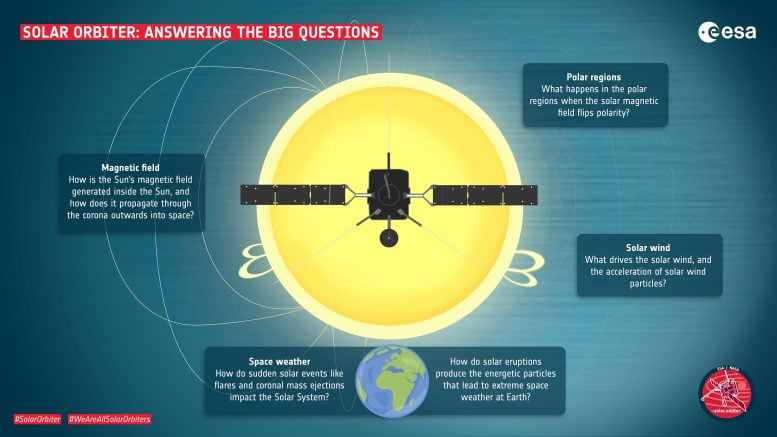
Solar Orbiter will address big questions in space science to help us understand how our star creates and controls the giant bubble of plasma – the heliosphere – that surrounds the whole Solar System and influences the planets within it. Credit: ESA–S.Poletti
“Scientifically, this exceeded our expectations by a large margin,” says Daniel Müller, Solar Orbiter Project Scientist. He explains that an upgrade to the ESA Ground Station Network allowed Solar Orbiter to send more data than expected back to Earth, and the mission’s scientists have been quick to take advantage. More than fifty papers detailing Solar Orbiter’s cruise phase science results are to be published in December by the journal Astronomy & Astrophysics.
Closer to the Sun
Now, however, it is time to start operating the two sets of instruments together as the mission shifts into the main science phase, and the anticipation is palpable. In March, Solar Orbiter will make a close pass to the Sun, called perihelion. Its first perihelion took place in June 2020, with the spacecraft closing to 77 million kilometers. This time, Solar Orbiter will draw to within 50 million kilometers – providing a significant boost to the science that can be done.
“This will be at a third of the distance between the Sun and Earth. So compared to all the interesting high resolution images that we’ve already gotten everything now will be zoomed in by about a factor of two,” says Daniel.
This includes new views of the enigmatic ‘campfires’ that Solar Orbiter saw at the first perihelion. The campfires could hold clues about how the Sun’s outer atmosphere has a temperature of millions of degrees, while the surface has a temperature of thousands – which seemingly defies physics because heat should not be able to flow from a colder to a hotter object.
And while Solar Orbiter is not going as close to the Sun as NASA’s Parker Solar Probe, this is by design because it allows Solar Orbiter to not only measure what is happening in the solar wind, but to also carry telescopes that can look at the Sun without being destroyed by the heat. The two data sets can then be compared to link activity on the Sun’s surface to the space weather around the spacecraft.
“This linkage science is what I find most exciting,” says Yannis Zouganelis, Solar Orbiter Deputy Project Scientist.
Observing challenge
But before any of this takes place, Solar Orbiter must complete its flyby of Earth. And this presents an opportunity for eagle-eyed sky watchers to bid a final farewell to the spacecraft before it heads forever into deep space.
In the moments leading up to closest approach, skywatchers in the Canaries and North Africa could catch a brief glimpse of the spacecraft speeding through the sky. It will be traveling at about 0.3 degrees per second, which is just over half the apparent diameter of the Moon every second. For most observers it will be too faint to spot with the unaided eye, and too fast for telescopes to track, so binoculars should provide the best chance of catching a glimpse.
When Solar Orbiter re-emerges from the Earth’s shadow it will be on course for its rendezvous with the Sun and the never-before-seen solar polar regions. The science phase of this ambition mission will have begun.





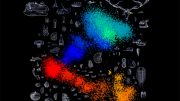


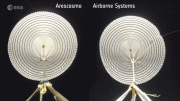
Be the first to comment on "Solar Orbiter’s Riskiest Flyby Is Imminent: Earth"